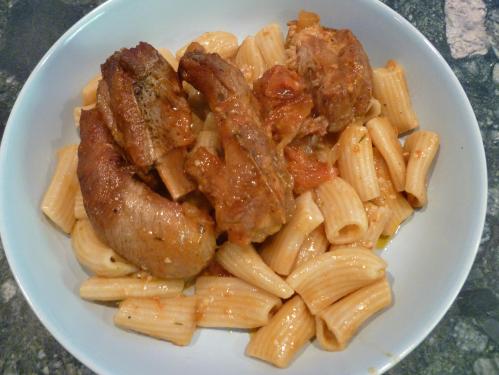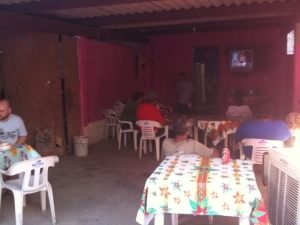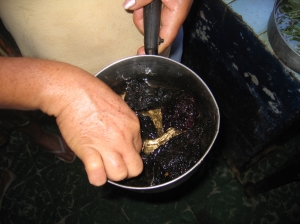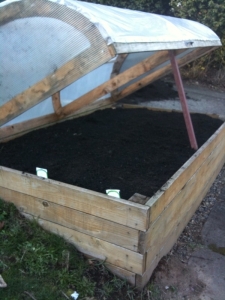
You are what I eat and I know that you felt every ounce of adrenaline pulsing through my body when I reeled in these Chinook Salmon for you to eat. I hope that when you eat, you will have a story to tell about where you food was grown or raised. Reeling in this salmon took me about 20 minutes and Stefan and our guide Jay gently guided me through every tug of my rod. Because I had no idea what I was doing. When we finally “landed the fish”, my first thought was how YOU felt about all of the commotion. Were you ok? Did you like it? Did I pull the muscles that are supporting you? Will this experience make you want to fish with Stefan and I? I hope so. I know so.
Stefan and I went on a road trip in the van the week of Labor Day.
We camped with friends on the Umpqua for 2 nights, camped at Cape Blanco, slept in a lodge on the Rogue river where we caught the 4 salmon, camped at Golds Bluff Beach in the Redwoods in Northern California, swam in the Smith River and had a fantastically fun baby shower with our Corvallis family.
Since our road trip, we have been staying close to home. This weekend, I made some good food.
Instructions
Heat oil in heavy large pot over high heat. Sprinkle spareribs with salt and pepper. Working in batches, add ribs to pot and brown on all sides, about 6 minutes.

Transfer ribs to bowl. Add onions, garlic, cherry peppers and crushed red pepper to pot. Sauté until onions just begin to brown, about 10 minutes. Add tomatoes with their juices. Using back of fork or potato masher, coarsely crush tomatoes. Return spareribs and juices to pot. Add broth, wine, thyme and bay leaves and bring to boil. Reduce heat to medium- low. Simmer uncovered until spareribs are very tender and sauce thickens, stirring occasionally, about 2 hours. Season with salt and pepper. (Can be made 2 days ahead. Cool slightly. Refrigerate until cold, then cover and keep chilled. Remove chilled fat from top of sauce, if desired. Rewarm before continuing.)

Cook pasta in large pot of boiling salted water until just tender but still firm to bite. Drain and return pasta to same pot. Add cheese, parsley and some sauce from spareribs and toss to coat. Transfer pasta to large bowl. Top with spareribs and remaining sauce and serve.
Zucchini Bread Cake
Ingredients
* 2 1/2 cups Flour
* 1/2 cup cornmeal
* 1/2 teaspoon salt
* 1 tablespoon baking powder
* 1 cup sugar
* 1 teaspoon cinnamon
* 1/2 teaspoon ginger
* pinch of nutmeg and cloves
* 2 eggs
* 1/4 cup melted butter, more for greasing pan
* 1 1/4 cups milk
* 1 cup shredded zucchini
Optional–chocolate chips, walnuts
Instructions
1. Preheat oven to 350 degrees. Grease a 9-by-5-inch loaf pan with butter, or butter.
2. In a large bowl, combine all dry ingredients.
3. Beat the egg with the butter and milk.
4. Fold in wet ingredients into the dry and add the zucchini. Batter should be lumpy, not smooth.
5. Pour into prepared loaf pan and bake about an hour.
–From Mark Bittman’s How to Cook Everything

Walnut Pesto

* 2 loosely packed cups fresh basil leaves, big stems discarded, rinsed and dried
* Salt to taste
* ½ to 2 cloves garlic, crushed
* 2 tablespoons pine nuts or walnuts, lightly toasted in a dry skillet
* ½ cup extra virgin olive oil, or more
* ½ cup freshly grated Parmesan or other hard cheese (optional)
Instructions
1. Combine the basil, salt, garlic, nuts and about half the oil in a food processor or blender (or mortar and pestle).
2. Process, stopping to scrape down the sides of the container occasionally, and adding the rest of the oil gradually. Add additional oil if you prefer a thinner mixture. Store in the refrigerator for a week or two, or in the freezer for several months (omit next step/cheese if freezing – and drizzle top with oil to preserve). Stir in the parmesan by hand just before serving.
–From Mark Bittman’s How to Cook Everything




































